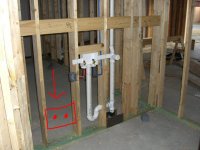flyingskydiver
New Member
I am wanting to put in a laundry sink next to our washer and dryer. I know that I can tap into the PEX cold and hot water lines for the studs, however, the drainage is where I do not know how to tap into on the design due to the venting on the opposite side. I have attached a picture of the current configuration, where the venting is on the right of the drainage, but need the studs to be on the left, as highlighted in red. Any direction and picture of how to achieve this would be great. Thank you.

